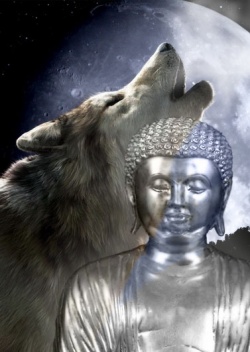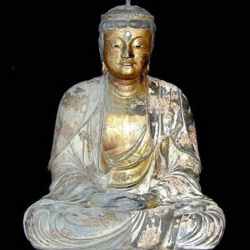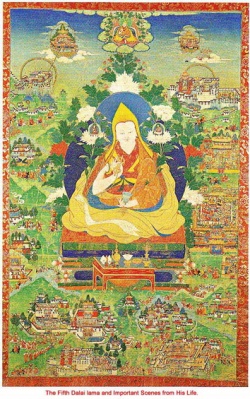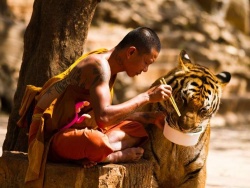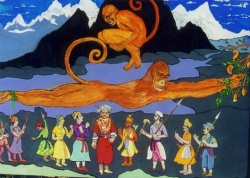The Inner Kālacakratantra - A Buddhist Tantric View of the Individual: Introduction
The Inner Kālacakratantra
A Buddhist Tantric View of the Individual
A. Wallace
Introduction
The Kālacakratantra is an early eleventh-century esoteric treatise belonging to the class of unexcelled yoga-tantras (anuttara-yoga-tantra). To the best of our knowledge, it was the last anuttara-yoga-tantra to appear in India. According to the Kālacakra tradition, the extant version of the Kālacakratantra is an abridged version of the larger original tantra, called the Paramādibuddha, that was taught by the Buddha Śākyamuni to Sucandra, the king of Sambhala and an emanation of Vajrapāṇi, in the Dhānyakaṭaka stūpa, a notable center of Mahāyāna in the vicinity of the present-day village of Amarāvatī in Andhra Pradesh. Upon receiving instruction on the Paramādibuddhatantra and returning to Sambhala, King Sucandra wrote it down and propagated it throughout his kingdom. His six successors continued to maintain the inherited tradition, and the eighth king of Sambhala, Mañjuśrī Yaśas, composed the abridged version of the Parāmadibuddhatantra, which is handed down to us as the Sovereign Abridged Kālacakratantra (Laghukālacakratantrarāja). It is traditionally taught that it is composed of 1,030 verses written in the sradgharā meter. [1] However, various Sanskrit manuscripts and editions of the Laghukālacakratantra contain a somewhat larger number of verses, ranging from 1,037 to 1,047 verses. The term an “abridged tantra” (laghu-tantra) has a specific meaning in Indian Buddhist tantric tradition. Its traditional interpretation is given in Naḍapādas (Nāropā) Sekoddeśaṭīkā, which states that in every yoga, yoginī, and other types of tantras, the concise, general explanations (uddeśa) and specific explanations (nirdeśa) make up a tantric discourse (tantra-saṃgīti), and that discourse, which is an exposition (uddeśana) there, is an entire abridged tantra.[2]
The tradition tells us that Mañjuśrī Yaśas's successor Puṇḍarīka, who was an emanation of Avalokiteśvara, composed a large commentary on the Kālacakratantra, called the Stainless Light (Vimalaprabhā), which became the most authoritative commentary on the Kālacakratantra and served as the basis for all subsequent commentarial literature of that literary corpus. The place of the Vimalaprabhā in the Kālacakra literary corpus is of great importance, for in many instances, without the Vimalaprabhā, it would be practically impossible to understand not only the broader implications of the Kālacakratantra' cryptic verses and often grammatically corrupt sentences but their basic meanings. It has been said that the Kālacakratantra is explicit with regard to the tantric teachings that are often only implied in the other anuttara-yoga-tantras, but this explicitness is actually far more characteristic of the Vimalaprabhā than of the Kālacakratantra itself.
According to Tibetan sources, the ācārya Cilupā from Orissa, who lived in the second half of the tenth century, after reading the Kālacakratantra in the monastery in Ratnagiri, undertook a journey to Sambhala in order to receive oral teachings that would illuminate the text. After his return to southern India, he initially had three students, one of whom was the great paṇḍita Piṇḍo, who was originally from Bengal. The ācārya Piṇḍo became a teacher of Kālacakrapāda the Senior, who was from northern Bengal (Varendra). After returning to eastern India, Kālacakrapāda the Se nior taught the Kālacakratantra to his disciples, the most famous of whom was Kālacakrapāda the Junior, who built the Kālacakra temple in Nālanda, believing that the propagation of the Kālacakratantra in Magadha would facilitate its propagation in all directions. I shall not discuss here all the variants in the accounts given by the Tibetan Rwa and 'Bro traditions of the history of the Kālacakratantra in India, for these accounts have already been narrated in other readily available works by other Western scholars and in English translations of the Tibetan sources.[3]
One of the references that seems significant for establishing the period of the propagation of the Kālacakratantra in India is the reference in the Kālacakratantra (Ch. 2, v. 27) and the Vimalaprabhā to the end of the sexagenary cycle that comes 403 years after the Hijrī, or Islamic era (mlecchendra-varṣa), of 622 ce. Likewise, the same texts assert that the hundred and eighty-second year after the Hijrī era is the period of the eleventh Kalkī, the king Aja, which is corroborated by the Kālacakrānusārigaṇita, [4] which states further that after the time of Kalkī Aja, 221 years passed till the end of the sexagenary cycle. Thus, adding 221 years to 182, one arrives at the number of 403 years after the Hijrī era. In light of this, I agree with G. Orofino in determining the year to be 1026 ce, relying on the Indian system of reckoning years, in which 623 ce is included in the span of 403 years. [5] This is in contrast to G. Grönbold and D. Schuh, who assumed without substantial evidence that the Kālacakra tradition incorrectly calculated the Hijrī era as beginning at 642 ce and thus determined the year to be 1027 ce by adding the span of 403 years to the year of 624 ce. [6]
According to the Vimalaprabhā commentary, the Paramādibuddhatantra was composed of twelve thousand verses, written in the anuṣṭubh meter. [7] However, we cannot determine now with certainty whether the Paramādibuddhatantra ever existed as a single text or as a corpus of mutually related writings, since we know from the Vimalaprabhā [8] that the Sekoddeśa, which circulated as an independent text in early eleventh-century India, has traditionally been considered to be a part of the Paramādibuddhatantra. Nearly two hundred and ten verses from the Ādibuddhatantra are cited throughout the five chapters of the Vimalaprabhā; and some verses attributed to the Paramādibuddhatantra are also scattered in other writings related to the Kālacakra literary corpus, such as the Sekoddeśaṭippanī [9] and the Paramārthasaṃgraha, [10] which cites the verse from the Paramādibuddhatantra that coincides with the opening verse of the ḍākinīvajrapañjaratantra. [11] Likewise, some citations from the Paramādibuddhatantra are found in the commentarial literature on the Hevajratantra, specifically—in the Hevajrapiṇḍāthaṭīkā [12] and in the Vajrapādasārasaṃgrahapañjikā. [13]
In addition to these, there are other pieces of textual evidence found in the Abridged Kālacakratantra and in the Vimalaprabhā, such as the repeated references to the Hevajratantra, the Guhyasamājatantra, the Cakrasaṃvaratantra, and to the Mañjus´rīnāmasaṃgīti, which the Vimalaprabhā identifies as the sixteenth chapter of the Māyājālatantra. These suggest that the Paramādibuddhatantra must have been composed after these tantric traditions of the seventh and eighth centuries were already well established.
The works of the eminent Indian Kālacakratantra adepts, such as those of Dārika, Anupamarakṣita, and Sādhuputra, which are preserved in the different versions of the Tibetan Bstan 'gyur, can be dated to the beginning of the eleventh century. The writings of the Bengali author Abhayākāragupta, who was a contemporary of the Bengali king Rāmapāla, and the works of Raviśrījñāna from Kaśmīr, can be traced to the late eleventh and early twelfth centuries. Likewise, the writings of the Bengali author Vibhūticandra who studied in Magadha, and the works of the Kaśmīr author Śākyasśrībhadra can be dated to the second half of the twelfth and the beginning of the thirteenth centuries. Some Tibetan authors indicate that although writing on the Kālacakratantra might have ceased in India with the Turkish invasions of Bihar and Bengal at the beginning of the thirteenth century, the Kālacakra tradition did not completely die in India until the fifteenth century. [14] In his History of Indian Buddhism, [15] Tāranātha mentions one of the last of the Indian Buddhist paṇḍitas, Vanaratna, from eastern Bengal, who in 1426 was the last Indian paṇḍita to reach Tibet through Nepal. Having reached Tibet, he taught and cotranslated several works of the Kālacakra corpus from Sanskrit into Tibetan. According to the Blue Annals, the best of the initiations and precepts of the Kālacakratantra came at that time from Vanaratna. [16] Thus, it seems that the doctrine and practice of the Kālacakratantra were promulgated in India for almost five centuries.
It is difficult to determine with certainty the parts of India in which the first authors of the Kālacakra tradition resided. The Tibetan accounts, however, indicate that even though the Kālacakra tradition initially may have started in south India, the Kālacakratantra's sphere of influence in India was confined to Bengal, Magadha (Bihar), and Kaśmīr, wherefrom it was transmitted to Nepal, Tibet, and eventually to Mongolia, where Kālacakra was instituted as the protective deity of the Mongol nation.
Footnotes
- ↑ This number of verses is given in the Vimalaprabhā commentary on the Kālacakratantra, Ch, 1. v. 9. The sradgharā meter consists of four lines (pada) of twenty-one syllables each.
- ↑ See Sekoddeśaṭīkā of Naḍapāda, 1941, pp. 4–5: uddeśa-nirdeśau dvāv eva tantra-saṃgītiḥ. tatroddeśanā-samgītiḥ samasta-laghu-tantram.
- ↑ For more detailed information on the Tibetan historical accounts of the history of the Kālacakratantra in India, see G. N. Roerich, tr., Blue Annals, 1988, pp. 753–766. For a wellsystematized presentation of the Tibetan accounts, see John Newman, “A Brief History of the Kālachakra, ” in The Wheel of Time: The Kalachakra in Context, 1985, pp. 51–84. See also Giacomella Orofino, Sekoddeśa, 1994, pp. 15–24.
- ↑ The Kālacakrānusārigaṇita, or the Kālacakragaṇitopadeśa, National Archives in Kathmandu, no. 152 VI, 22, Mf. B22/22. According to the Kālacakrānusārigaṇita, the Kālacakra era (dhruvaka) corresponds to the nineteenth year of the Jupiter cycle, which, according to G. Orofino, falls forty-one years before the end of the sexagenary cycle. On this basis, Orofino, 1994, p. 16, presumes that the astronomical era of the Kālacakratantra's laghu-karaṇa corresponds to 805 ce of the Gregorian calendar.
- ↑ See G. Orofino, 1994, p. 15 and fn. 27.
- ↑ G. Grönbold, 1991, p. 393; D. Schuh, 1973, p. 20.
- ↑ The anuṣṭubh meter consists of the four lines (pada) of eight syllables each.
- ↑ The Vimalaprabhā commentary on the Kālacakratantra, Ch. 2, v. 99, citing v. 86 from the Sekoddeśa, states that the verse was taught by the Bhagavān in the Sekoddeśa in the roottantra (mūla-tantra). Likewise, the Vimalaprabhā commentary on the Kālacakratantra, Ch. 2, v. 107, asserts the same, citing verses 51–52b.
- ↑ The Sekoddeśaṭippanī of Sādhuputra, Asiatic Society of Bengal, Calcutta, MS. 10744, folio 1b/3– 5. Tib.
- ↑ Paramārthasaṃgrahanāmasekoddeśaṭīkā of Nāropā, 1941, pp. 3–4.
- ↑ The Ārya-ḍākinī-vajrapañjara-mahātantrarājakalpa-nāma of the unknown author is extant only in Tibetan translation, Derge edition, rgyud #419. G. Orofino, 1994, p. 14, points out that according to Bu ston's Tantra Catalogue, it is associated with the literary corpus of the Hevajratantra. However, this is not the case according to the Nyingma edition of the sDe-dge bKa'-'gyur/bsTan-'gyur.
- ↑ The Hevajrapiṇḍārthaṭīkā of Vajragarbhadaśabhūmīśvara, National Archives, Kathmandu, C 128, Mf., C 12/6.
- ↑ See the Vajrapādasārasaṃgrahapañjikā of Nāḍapāda (Nāropā), Peking ed. of The Tibetan Tripiṭaka, 2070, p. 148, 4b/1.
- ↑ See G. Orofino, 1994, p. 23, and J. Newman, “Outer Wheel of Time, ” 1987, p. 112.
- ↑ Tāranātha's History of Buddhism in India, 1990, p. 440.
- ↑ Blue Annals, p. 797.
Continue reading
- The Inner Kālacakratantra - A Buddhist Tantric View of the Individual: Preface
- The Inner Kālacakratantra - A Buddhist Tantric View of the Individual: Introduction
- The Inner Kālacakratantra - A Buddhist Tantric View of the Individual: The Broader Theoretical Framework of the Kālacakratantra
- The Inner Kālacakratantra - A Buddhist Tantric View of the Individual: A History of the Ṣaḍ-aṅga-yoga of the Kālacakratantra and Its Relation to Other Religious Traditions of India
- The Inner Kālacakratantra - A Buddhist Tantric View of the Individual: The Nature of Syncretism in the Kālacakratantra
- The Inner Kālacakratantra - A Buddhist Tantric View of the Individual: The Concept of Science in the Kālacakra Tradition
- The Inner Kālacakratantra - A Buddhist Tantric View of the Individual: The Cosmic Body
- The Inner Kālacakratantra - A Buddhist Tantric View of the Individual: The Social Body
- The Inner Kālacakratantra - A Buddhist Tantric View of the Individual: The Gnostic Body
- The Inner Kālacakratantra - A Buddhist Tantric View of the Individual: The Transformative Body
Source
